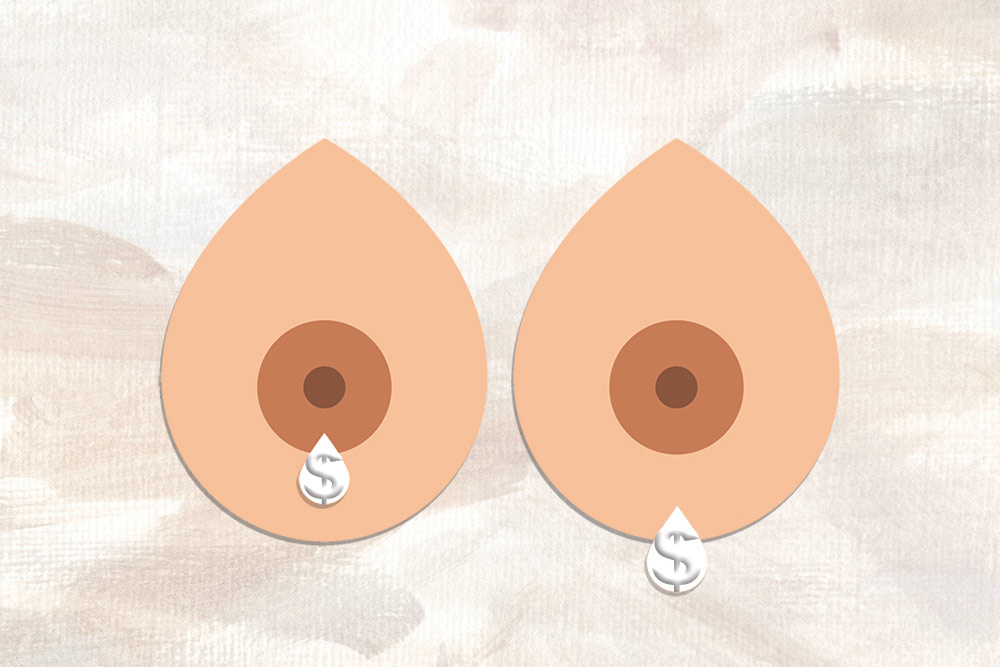The True Cost of Breastfeeding

In financially preparing for your wee one’s arrival, you may assume that feeding your baby breast milk is the ultimate way to save money. After all, you’ve probably heard plenty of people excitedly claim, “One of the benefits of breastfeeding is that it’s free!” While it may be true that the cost of formula comes with an obvious price tag, there are actually many fees associated with nursing during babe’s first year of life.
Before we dive in, it’s worth addressing that we absolutely recognize it’s not just your wallet that’s affected by having a breast fed babe. A nursing mother’s time, body, and sometimes sanity, are also impacted. We know it’s a sacrifice and aim here to highlight the indirect costs that can be missed by new parents while also acknowledging that all those milky minutes devoted to babies are extremely valuable, too! Cool? Awesome!
First, let’s get a quick financial rundown of formula feeding. Infant formula has a vast price spectrum per container, ranging from about $70 to $250 per month for an exclusively formula-fed baby. On the lower end, that’s about $900; on the higher end, that could equal around $3,000 spent on formula by the time you have a 1-year-old.
In addition, you’ll of course need baby bottles and may opt for other convenient accessories, such as a bottle warmer, drying rack, holder for your stroller, etc. that all play into a grand total for the cost of formula feeding your newborn.
While those figures may give you some slight sticker shock, remember there are some expenses to consider if planning to breastfeed, too. No matter which way you slice it, mom and baby needs cost money.
Lactation Consultant Visit
Breastfeeding mothers often find out that while nursing may be natural, it’s not always intuitive or easy. Thankfully there are expert resources available to help you troubleshoot issues and establish a breastfeeding routine early on.
A lactation consultant is a healthcare professional who specializes in supporting and caring for nursing moms. From helping with baby’s latch to positioning tactics to advice on clearing a clogged duct, they’re the go-tos to help you achieve your feeding goals in the most comfortable, confident way possible.
There are different levels of expertise, but your best bet is to book an appointment (either in-home or at a clinic) with an International Board Certified Lactation Consultant (IBCLC) for top-tier assistance. These consultations vary between $150-$350 per visit. Some health insurance plans cover a portion of the fee, so it’s a worthy idea to call beforehand and estimate your out-of-pocket cost.
Breastfeeding Equipment + Accessories
Your most important hardware is built-in (aka your leading ladies), but there are handy helpers that make the process more seamless—for a price.
Breast Pump
Thanks to the Affordable Care Act, you can receive a free breast pump through your insurance. However, not all pumps fall under this offer, and depending on your lifestyle and pumping needs (such as discreetly pumping at the office or needing something with hospital strength suction), you may be looking at paying a discounted rate for a higher-grade pump or will have to purchase one in full. For example, the popular Elvie wearable pump costs $500 per set and requires additional payment, while a tried-and-true base model electric pump will likely be fully covered by insurance. (Tip: Elvie recently launched the Elvie Stride pump specifically for insurance. Check it out!)
Nursing Pillow
Breastfeeding requires pillows—lots and lots of pillows! Your back needs the support, and your little bambino will quickly start to grow from their newborn size, making it harder to hold them for meals without backup. An obvious must-have, nursing pillow will cost you around $35 and up.
Nursing Bras/Clothing
Yes, you can technically nurse in any clothing, but nursing-friendly bras, shirts and coverups make life so much easier! Just like you can do your best to stuff your bump into your everyday wardrobe, it’s way more comfortable and practical to have some pieces that are made for the job. (If you’re expressing regularly, it’s also worth looking into pumping bras.) The price of these garments vary greatly, but know they’re generally more expensive than their non-nursing counterparts.
Supplements and Lactation Foods
Ramping up and maintaining your milk supply may involve certain supplements with Fenugreek, blessed thistle, anise, red raspberry leaf, fennel and turmeric as active ingredients. These concoctions help boost milk production and also come in tasty treats (like cookies, brownies, coffees and teas) if you’re not keen on swallowing pills. Look to spend anywhere from $15-$100 for these products.
Accessories
Sometimes it’s the small things that add up to make the biggest difference, especially if you have to replace these items more often. Nursing pads, milk storage bags, nipple cream, nipple formers and shields, and some soft muslin cloths to help keep you clean and dry are all part of the equation for many moms.
While we’re here to enthusiastically advocate for a mom to breastfeed if she wants to, the point is that it’s not totally free, and expenses should be factored in when planning for maternity leave or making a post-baby budget.







